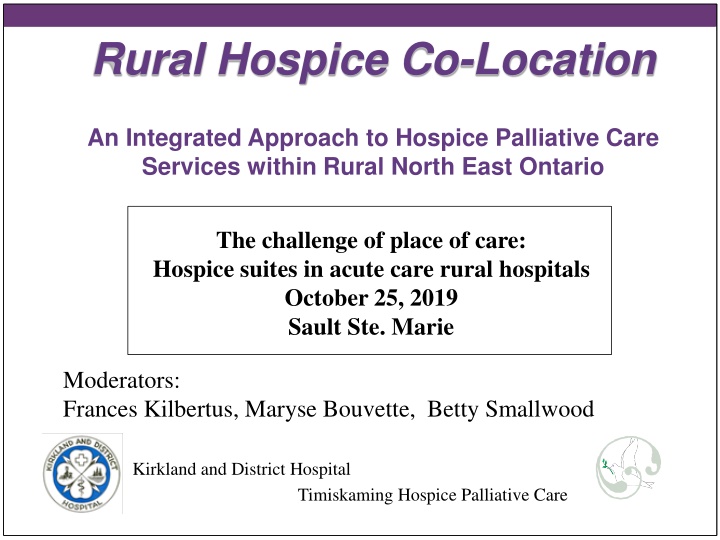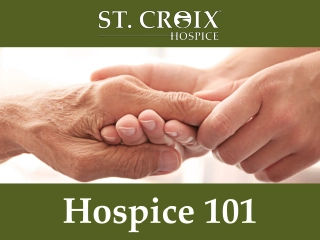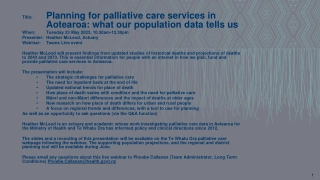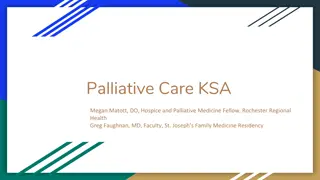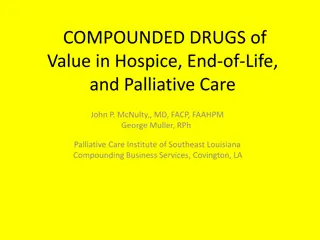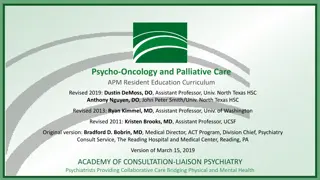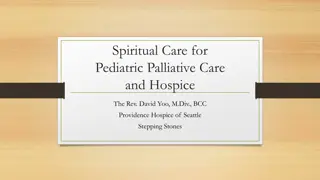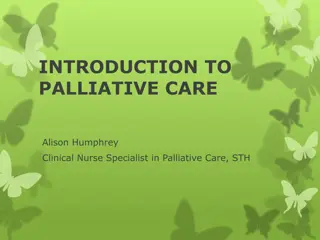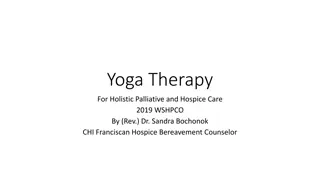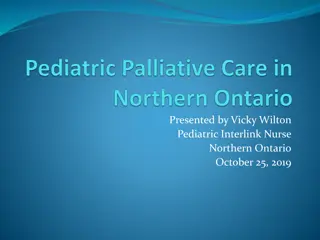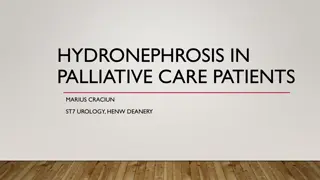Rural Hospice Co-Location: An Integrated Approach to Hospice Palliative Care Services within Rural North East Ontario
Challenges in providing hospice care in rural areas of North East Ontario are addressed through the innovative approach of co-locating hospice suites in acute care rural hospitals. This co-location model aims to bridge gaps in service delivery, improve access to care, and enhance coordination for individuals with cancer or chronic life-limiting illnesses. The community-driven vision of incorporating hospice care within existing infrastructures showcases a promising quality intervention opportunity. The case study of Timiskaming District highlights the positive impact of the pilot project initiated at Kirkland and District Hospital.
Download Presentation

Please find below an Image/Link to download the presentation.
The content on the website is provided AS IS for your information and personal use only. It may not be sold, licensed, or shared on other websites without obtaining consent from the author.If you encounter any issues during the download, it is possible that the publisher has removed the file from their server.
You are allowed to download the files provided on this website for personal or commercial use, subject to the condition that they are used lawfully. All files are the property of their respective owners.
The content on the website is provided AS IS for your information and personal use only. It may not be sold, licensed, or shared on other websites without obtaining consent from the author.
E N D
Presentation Transcript
Rural Hospice Co-Location An Integrated Approach to Hospice Palliative Care Services within Rural North East Ontario The challenge of place of care: Hospice suites in acute care rural hospitals October 25, 2019 Sault Ste. Marie Moderators: Frances Kilbertus, Maryse Bouvette, Betty Smallwood Kirkland and District Hospital Timiskaming Hospice Palliative Care
Timiskaming District 14,000 sq km landmass 34,000 population (1 hospice bed/ 100,000=1.99 beds) 3 central areas - Kirkland Lake, Englehart, Temiskaming Shores Many outlying towns & villages Significant health challenges and poor socioeconomic and lifestyle factors These characteristics are typical of each of the rural districts/hubs in NE Ontario
Issues and their Impact on Patients Individuals travel long distances to be diagnosed, and later to receive treatment throughout their illness trajectory Decentralization of hospitals in the 90 s, though best practice for the patient and our health care system, has created additional challenges to deliver and obtain care in community Individuals with cancer or chronic life-limiting illness, who are being cared for at home, find themselves having to be treated in Emergency Department and/or admitted to Hospital for pain and symptom management, or when family no longer able to cope Gaps in HPC Service Delivery: In care setting here are no dedicated palliative care beds in any of the three hospitals in the District; and no hospice care beds in the District. Lack of Coordination of care and services for individuals throughout their illness trajectory.
Quality Intervention and Implementation Opportunity and Vision Community Partners idea to incorporate Hospice Care within existing infrastructures, across the District Right timing / Right leadership Repurposing of unused space (an obstetrics ward) within the Kirkland and District Hospital (KDH) Fall of 2013 a dedicated 1-bed community hospice suite was opened as a pilot project in the KDH Oct 2013 - A proposal to develop this model as an Integrated Rural Hospice Co-location Model was endorsed by the Kirkland and District Hospital, and the Timiskaming District Hospice Palliative Care local planning table
Outcomes/Impact of 1-Bed Rural Hospice Suite Co-Location Model: For the Patient and Families For Service Providers Truly at centre of care and in better control over their lives Focus on all domains of issues physical, spiritual, psychosocial Reduction in caregiver burnout Improved hospice palliative care awareness and use of common resources (PPS and CCO Symptom Guidelines) Improved skills, confidence and practice amongst all settings For the Health Care System For Local Integration Opportunity for direct admission from home Development of capacity to serve patient in location of choice Co-location model builds on space, heating, maintenance, IT and other supports provided by the hospital Rural hospice is not sustainable as a stand alone model Building capacity to deliver hospice care, while improving the quality of palliative and EOL care Early identification and capacity amongst providers is key Successfully evaluated against Hospice Palliative Care Ontario s Community Residential Hospice Standards of care.
Rural Hospice Suite Co-located at Kirkland and District Hospital The Hospice Suite provides a home-like environment End-of-Life care services are offered by an inter-professional team with palliative care expertise 24 hours a day, 7 days a week. Significant connections have been established with all providers This Community Model of Hospice Palliative Care promotes the understanding that care and support begins at the time of diagnosis, not solely when patients are admitted to the Hospice Suite.
Sustainability and Sharing of the Initiative Demonstrated that, in a rural area, 1-bed hospice suite and program can be co-located within an existing infrastructure to: provide quantifiable improvements to the patient experience at end-of-life; enhance the continuum of care; support the family through the dying and bereavement process; and, provide value for money. To improve access to service in rural communities and build capacity for hospice palliative care in line with provincial direction, the NE LHIN endorsed the co-location model developed as a pilot project in Kirkland Lake and in 206-2017 (17 hospitals within the NE received start up financing) 17 hospitals in NE now receive annualized funding as a Hospice bed - $105,000 per bed which is directed toward nursing and PSW supports. Two of the early pilot sites are awaiting funding
Survey Discussions What has the effect of a One Bed Hospice in an Acute Care Setting been? ---------------------------------------- In relation to the care delivery & the management of clients/families within the Rural Hospice Palliative Care Co-Location Suite within your Community hospital: What are the strengths? What have you found to be a challenging? What improvements can be made?
SUMMARY Post Survey & Conference: What improvements can be made? THEMES IDENTIFIED: FUNDING & SUSTAINABILIY EDUCATION & SUPPORT EARLY IDENTICATION STRATEGIES (EARLY IDNETIFICATION OF PERSONS WHO WOULD BENEFIT FROM A PALLIATIVE APPROACH TO CARE) DEVELOP COMMUNITY INTEGRATED TEAM APPROACH
